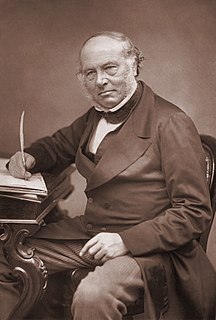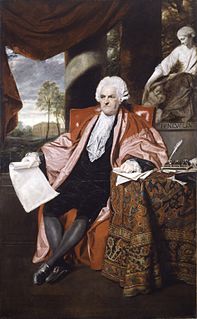
William Small was a Scottish physician and a professor of natural philosophy at the College of William and Mary in Virginia, where he became an influential mentor for Thomas Jefferson.

Birmingham Town Hall is a concert hall and venue for popular assemblies opened in 1834 and situated in Victoria Square, Birmingham, England. It is a Grade I listed building.

Dr Joseph Sampson Gamgee, MRCS, FRSE was a surgeon at the Queen's Hospital in Birmingham, England. He pioneered aseptic surgery, and, in 1880 invented Gamgee Tissue, an absorbent cotton wool and gauze surgical dressing.

The Birmingham Triennial Musical Festival, in Birmingham, England, founded in 1784, was the longest-running classical music festival of its kind. It last took place in 1912.

Sir Rowland Hill, KCB, FRS was an English teacher, inventor and social reformer. He campaigned for a comprehensive reform of the postal system, based on the concept of Uniform Penny Post and his solution of pre-payment, facilitating the safe, speedy and cheap transfer of letters. Hill later served as a government postal official, and he is usually credited with originating the basic concepts of the modern postal service, including the invention of the postage stamp.
Events from the year 1836 in the United Kingdom.

Birmingham Children's Hospital is a specialist children's hospital located in Birmingham, England. The hospital provides a range of specialist services including major trauma care, paediatric intensive care, cardiac, renal, hepatic, orthopaedic surgeries, and operates the Child and Adolescent Mental Health Services (CAMHS) for the city. The service operates as part of Birmingham Women's and Children's NHS Foundation Trust, whose CEO is Sarah-Jane Marsh.

Southwark was a constituency centred on the Southwark district of South London. It returned two Members of Parliament to the House of Commons of the English Parliament from 1295 to 1707, to the Parliament of Great Britain from 1707 to 1800, and to the UK Parliament until its first abolition for the 1885 general election. A seat of the same name, covering a smaller area than the last form of the earlier seat in the west of the original and beyond its boundaries to the southwest, was created in 1950 and abolished in 1974.

Sampson Lloyd was an English iron manufacturer and banker, who co-founded Lloyds Bank. He was part of the notable Lloyd family of Birmingham.
The Birmingham Street Commissioners were created in Birmingham, England by the Birmingham Improvement Act 1769. Subsequent Improvement Acts of 1773, 1801, and 1812 gave increased powers to the Street Commissioners. In 1812, they became responsible for the repair and drainage of roads.

William Sands Cox was a surgeon in Birmingham, England. He founded Birmingham's first medical school in 1825 as a residential Anglican-based college in Temple Row, where a blue plaque commemorates him on the House of Fraser department store, and in Brittle Street. Cox went on to found the Queen's Hospital in Bath Row as a practical resource for his medical students.

Chance Brothers and Company was a glassworks originally based in Spon Lane, Smethwick, West Midlands, in England. It was a leading glass manufacturer and a pioneer of British glassmaking technology.

Great Junction Street is a street in Leith, on the northern outskirts of Edinburgh, Scotland. It runs southeast to northwest following approximately the southwestmost line of the old town walls around Leith.

Birmingham Accident Hospital, formerly known as Birmingham Accident Hospital and Rehabilitation Centre, was established in April 1941 as Birmingham's response to two reports, the British Medical Association's Committee on Fractures (1935) and the Interdepartmental Committee (1939) on the Rehabilitation of Persons injured by Accidents. Both organisations recommended specialist treatment and rehabilitation facilities. The hospital, generally recognized as the world's first trauma centre, used the existing buildings of Queen's Hospital, a former Teaching Hospital in Bath Row, Birmingham, England, in the United Kingdom. It changed its name to Birmingham Accident Hospital in 1974 and closed in 1993. A listed building it is now part of Queens Hospital Close, a student accommodation complex. A blue plaque commemorates its former role.

The Martineau family is an intellectual, business and political dynasty associated first with Norwich and later also London and Birmingham, England. The family were prominent Unitarians; a room in London's Essex Hall, the headquarters building of the British Unitarians, was named after them. Martineau Place in the city's Central Business District was named in their honour.

John Ash, was an English physician and founder of Birmingham General Hospital.

The Royal Hotel, originally just The Hotel, was a hotel located on Temple Row in Birmingham, England. Opened in 1772, it was the first establishment in Birmingham to describe itself as a "hotel", a new term entering usage around this time to denote a more fashionable and genteel establishment than the more traditional inn.

John Thackray Bunce was a British journalist and author. He served as editor of Aris's Birmingham Gazette from 1860 to 1862, and of the Birmingham Post from 1862 to 1898.

Dolobran, in the county of Montgomeryshire in Wales, is a historic estate which was the earliest known seat of the expansive Lloyd family, prominent Quakers, of which in the 18th century a junior branch, the Lloyd family of Birmingham, seated at Farm, Bordesley, became prominent in and around Birmingham as iron-founders and founded Lloyds Bank, today one of the largest banks in the United Kingdom. The grade II* listed manor house known as Dolobran Hall about 8 miles north-west of the town of Welshpool, is situated in the parish of Meifod to the west of the village of Meifod and to the east of the village of Pontrobert. One of the family historians, Humphrey Lloyd (1975), estimated the historic estate of Dolobran to have comprised about 1,000 acres. In 2015 Dolobran Hall and its 70-acre estate are used for farming and industrial training by the J.M. Evans Partnership. John Meirion Evans (1926–2015) of Dolobran Hall by his wife Edith was father to Maurice, Keith and Robert. In 2008 former farmer Rob Evans founded a company to train construction workers in the use of plant and machinery called "Training For The Future", based at "The Brick Barn Dolobran Hall".

Farm is an historic estate within the former manor of Bordesley, now situated in the area of Sparkbrook, a suburb of Birmingham, England. It has been described as the "focal point in family mythology" for the prominent and wide-spread Lloyd family, Quakers, iron producers and founders of Lloyds Bank.

























